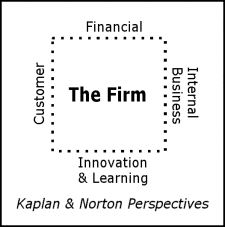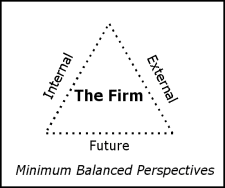reprint from: Robert Fabian  Balanced Scorecards are certainly winning mind-share. One consulting firm estimates that 80% of Fortune 1000 firms will do something with Balanced Scorecards this year. The Gartner research group projects that at least 40% of Fortune 1000 firms will implement Balanced Scorecards by the year 2000. Balanced Scorecards are certainly winning mind-share. One consulting firm estimates that 80% of Fortune 1000 firms will do something with Balanced Scorecards this year. The Gartner research group projects that at least 40% of Fortune 1000 firms will implement Balanced Scorecards by the year 2000. The idea is simple. The traditional measures have been financial. No organization can survive if it ignores these measures, but few organizations will prosper if they only pay attention to financial matters. The Balanced Scorecard approach takes a broader view. The name "Balanced Scorecard" comes from a 1992 Harvard Business Review article "The Balanced Scorecard - Measures That Drive Performance" by Kaplan and Norton. They identify four key perspectives: 
Customer retention ratios can be an indication of success from the Customer Perspective. And percentage of business from new products and services can be an indication of success from the Innovation and Learning Perspective. A KPI for the Internal Business Perspective might be cycle time reduction in different departments. There is an on-going debate about the degree to which every organization should use these four specific perspectives, and the degree to which every organization should follow the Kaplan and Norton approach to assessing KPI success.  In my experience, what matters is that an organization pay attention to Key Performance Indicators that cover the Internal, External, and Future Perspectives. Further, the selected Key Performance Indicators should look beyond what has happened, to what will happen - they need to be pro-spective as well as retro-spective. In my experience, what matters is that an organization pay attention to Key Performance Indicators that cover the Internal, External, and Future Perspectives. Further, the selected Key Performance Indicators should look beyond what has happened, to what will happen - they need to be pro-spective as well as retro-spective.In one form or another, the important ideas behind the Balanced Scorecard have been around for years. They are really just an argument for a balanced view of the firm and for indicators that look forward and well as backward. This is a minimum requirement for effective management. There are a number of difficult implementation issues. Many technology vendors are crying, "Pick me! I have the technology to make Balanced Scorecards work." Picking the right technology is important, but only after you have determined the problems that the technology should be used to solve. Balanced Scorecards, or any other measurement scheme, will be pointless if people are not held accountable for meeting their commitments. It's too easy to pretend. The firm spends much time measuring things, and that feels good and righteous, but it never uses the resulting measures to determine the success of any individuals. It's a common trap. Once a firm takes the essential step of holding people accountable, then it can think about Balanced Scorecards. In theory, Balanced Scorecards can work if implemented either bottom-up or top-down. In practice, if the most senior people in the organization don't pay attention to the new measures, success is unlikely. The organization that wants to begin working with a Balanced Scorecard approach has a number of choices. Many vendors of Data Warehouse, Data Mart, and OnLine Analytical Processing products have a Balanced Scorecard story. Vendors of Performance Management and Activity Based Costing systems can also have a story to tell. And there will be new choices as a result of Microsoft's "Plato" server, due out later this year. The two Canadian Balanced Scorecard vendors present an interesting contrast. I'm biased in favor of a selection process that begins by examining the other users of a vendor's products. There is comfort in user community which shares your concerns. Assuming the user community is right, and the product has the basic features you need, I turn to questions of style:
There are good reasons why firms are paying attention to Balanced Scorecards. They can make a difference. Balanced Scorecards may have faddish elements, but that doesn't make them any less important. And the basic ideas are timeless. |